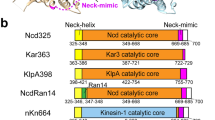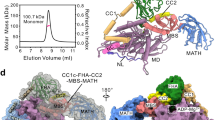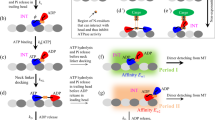Abstract
Most kinesins move processively along microtubules by using energy derived from ATP hydrolysis. Almost all of the intermediate structures of this ATPase reaction cycle have been solved for the monomeric kinesin 3 family motor KIF1A. Based on this structural information, we propose a common mechanism of kinesin motility, focusing on the regulation of kinesin motility through their interaction with microtubules and by their 'neck-linker' region, which connects their motor domain to cargo and kinesin partner heads.
This is a preview of subscription content, access via your institution
Access options
Subscribe to this journal
Receive 12 print issues and online access
$189.00 per year
only $15.75 per issue
Buy this article
- Purchase on Springer Link
- Instant access to full article PDF
Prices may be subject to local taxes which are calculated during checkout




Similar content being viewed by others
References
Hirokawa, N. & Noda, Y. Intracellular transport and kinesin superfamily proteins, KIFs: structure, function, and dynamics. Physiol. Rev. 88, 1089–1118 (2008).
Hirokawa, N., Noda, Y., Tanaka, Y. & Niwa, S. Kinesin superfamily motor proteins and intracellular transport. Nature Rev. Mol. Cell Biol. 10, 682–696 (2009).
Aizawa, H., Sekine, Y., Takemura, R., Zhang, Z., Nangaku, M. & Hirokawa, N. Kinesin family in murine central nervous system. J. Cell Biol. 119, 1287–1296 (1992).
Miki, H., Setou, M., Kaneshiro, K. & Hirokawa, N. All kinesin superfamily protein, KIF, genes in mouse and human. Proc. Natl Acad. Sci. USA. 98, 7004–7011 (2001).
Miki, H., Okada, Y. & Hirokawa, N. Analysis of the kinesin superfamily: insights into structure and function. Trends Cell Biol. 2005 15, 467–476 (2005).
Lawrence, C. J. et al. A standardized kinesin nomenclature. J. Cell Biol. 1, 19–22 (2004).
Moores, C. A. & Milligan, R. A. Lucky 13 – microtubule depolymerisation by kinesin-13 motors. J. Cell Sci. 119, 3905–3913 (2006).
Endow S. A. Determinants of molecular motor directionality. Nature Cell Biol. 6, E163–E167 (1999).
Vale, R. D. et al., Identification of a novel force-generating protein, kinesin, involved in microtubule-based motility. Cell 42, 39–50 (1985).
Brady, S. T. A novel brain ATPase with properties expected for the fast axonal transport motor. Nature 317, 73–75 (1985).
Okada, Y., Yamazaki, H., Sekine-Aizawa, Y. & Hirokawa, N. The neuron-specific kinesin superfamily protein KIF1A is a unique monomeric motor for anterograde axonal transport of synaptic vesicle precursors. Cell 81, 769–780 (1995).
Yonekawa, Y. et al. Defect in synaptic vesicle precursor transport and neuronal cell death in KIF1A motor protein-deficient mice. J. Cell Biol. 141, 431–441 (1998).
Niwa, S., Tanaka, Y. & Hirokawa, N. KIF1Bβ- and KIF1A-mediated axonal transport of presynaptic regulator Rab3 occurs in a GTP-dependent manner through DENN/MADD. Nature Cell Biol. 10, 1269–1279 (2008).
Hall, D. H. & Hedgecock, E. M. Kinesin-related gene unc-104 is required for axonal transport of synaptic vesicles in C. Elegans. Cell 65, 837–847 (1991).
Howard, J., Hudspeth, A. J. & Vale, R. D. Movement of microtubules by single kinesin molecules. Nature 342, 154–158 (1989).
Block, S. M., Goldstein, L. S. & Schnapp, B. J. Bead movement by single kinesin molecules studied with optical tweezers. Nature 348, 348–352 (1990).
Svoboda, K., Schmidt, C., F., Schnapp, B. J. & Block, S. M. Direct observation of kinesin stepping by optical trapping interferometry. Nature 365, 721–727 (1993).
Hackney, D. D. Highly processive microtubule-stimulated ATP hydrolysis by dimeric kinesin head domains. Nature 377, 448–450 (1995).
Vale, R. D., Funatsu, T., Pierce, D. W., Romberg, L., Harada, Y. & Yanagida, T. Direct observation of single kinesin molecules moving along microtubules. Nature 380, 451–453 (1996).
Okada, Y. & Hirokawa, N. A processive single-headed motor: kinesin superfamily protein KIF1A. Science 283, 1152–1157 (1999).
Hackney, D. D. Evidence for alternating head catalysis by kinesin during microtubule-stimulated ATP hydrolysis Proc. Natl Acad. Sci. USA 91, 6865–6869 (1994).
Hirokawa, N. et al. Submolecular domains of bovine brain kinesin identified by electron microscopy and monoclonal antibody decoration. Cell 56, 867–878 (1989).
Asbury, C. L., Fehr, A. N. & Block, S. M. Kinesin moves by an asymmetric hand-over-hand mechanism. Science 302, 2130–2134 (2003).
Kaseda, K., Higuchi, H. & Hirose, K. Alternate fast and slow stepping of a heterodimeric kinesin molecule. Nature Cell Biol., 5, 1079–1082 (2003).
Yildiz, A., Tomishige, M., Vale, R. D. & Selvin, P. R. Kinesin walks hand-over-hand. Science 303, 676–678 (2004).
Okada, Y. & Hirokawa, N. Mechanism of the single-headed processivity: diffusional anchoring between the K-loop of kinesin and the C terminus of tubulin. Proc. Natl Acad. Sci. USA. 97, 640–645 (2000).
Okada, Y., Higuchi, H. & Hirokawa, N. Processivity of the single-headed kinesin KIF1A through biased binding to tubulin. Nature 424, 574–577 (2003).
Kapitein, L. C. et al. Microtubule cross-linking triggers the directional motility of kinesin-5. J. Cell Biol., 181, 421–428 (2008).
Helenius, J., Brouhard, G., Kalaidzidis, Y., Dies, S. & Howard, J. The depolymerizing kinesin MCAK uses lattice diffusion to rapidly target microtubule ends. Nature 441, 115–119 (2006).
Ovechkina, Y., Wagenbach, M. & Wordeman, L. K-loop insertion restores microtubule depolymerizing activity of a “neck-less” MCAK mutant. J. Cell Biol. 159, 557–562 (2002).
Kull, F. J., Sablin, E. P., Lau, R., Fletterick, R. J. & Vale, R. D. Crystal structure of the kinesin motor domain reveals a structural similarity to myosin. Nature 380, 550–555 (1996).
Tomishige, M., Klopfenstein, D. R. & Vale, R. D. Conversion of Unc104/KIF1A kinesin into a processive motor after dimerization. Science 297, 2263–2267 (2002).
Hoeng, J. C. et al. High-resolution crystal structure and in vivo function of a kinesin-2 homologue in Giardia intestinalis. Mol. Biol. Cell 19, 3124–3137 (2008).
Kikkawa, M. et al. Switch-based mechanism of kinesin motors. Nature 411, 439–445 (2001).
Turner, J. et al. Crystal structure of the mitotic spindle kinesin Eg5 reveals a novel conformation of the neck-linker. J. Biol. Chem. 276, 25496–25502 (2001).
Cochran, J. C. et al. ATPase cycle of the nonmotile kinesin NOD allows microtubule end tracking and drives chromosome movement. Cell 136, 110–122 (2009).
Ogawa, T., Nitta, R., Okada, Y. & Hirokawa, N. A common mechanism for microtubule destabilizers — M type kinesin stabilize curling of the protofilament using the class-specific neck and loops. Cell 116, 591–602 (2004).
Sablin, E. P., Kull, F. J., Cooke, R., Vale, R. D. & Fletterick, R. J. Crystal structure of the motor domain of the kinesin-related motor ncd. Nature 380, 555–559 (1996).
Nitta, R., Kikkawa, M., Okada, Y. & Hirokawa, N. KIF1A alternately uses two loops to bind microtubules. Science 305, 678–683 (2004).
Nitta, R., Okada, Y. & Hirokawa, N. Structural model for strain-dependent microtubule activation of Mg-ADP release from kinesin. Nature Struct. Mol. Biol. 15, 1067–1075 (2008).
Kull, F. J. & Endow, S. A. Kinesin: switch I & II and the motor mechanism. J. Cell Sci. 115, 15–23 (2002).
Sindelar, C. V. & Downing, K. H. The beginning of kinesin's force-generating cycle visualized at 9A resolution. J. Cell Biol. 177, 377–385 (2007).
Hirose, K., Akimaru, E., Akiba, T., Endow, A. S. & Amos, L. A. Large conformational changes in a kinesin motor catalyzed by interaction with microtubules: Mol. Cell 23, 913–923 (2006).
Kikkawa, M. & Hirokawa, N. High-resolution cryo-EM maps show the nucleotide binding pocket of KIF1A in open and closed conformations. EMBO J. 25, 4187–4194 (2006).
Rice, S. et al. A structural change in the kinesin motor protein that drives motility. Nature 402, 778–784 (1999).
Thorn K. S., Ubersax J. A., Vale R. D. Engineering the processive run length of the kinesin motor. J. Cell Biol. 151, 1093–1100 (2000).
Jiang, W., Stock, M. F., Li, X. & Hackney, D. D. Influence of kinesin neck domain on dimerization and ATPase kinetics. J. Biol. Chem. 272, 7626–7632 (1997).
Case, R. B., Rice, S., Hart, C. L., Ly, B. & Vale, R. D. Role of the kinesin neck linker and catalytic core in microtubule-based motility. Curr. Biol. 10, 157–160 (2000).
Rice, S. et al. Thermodynamic properties of the kinesin neck region docking to the catalytic core. Biophys. J. 84, 1844–1854 (2003).
Uemura, S. & Ishiwata, S. Loading direction regulates the affinity of ADP for kinesin. Nature Struct. Biol. 4, 308–311 (2003).
Rosenfeld, S. S., Fordyce, P. M., Jefferson, G. M., King, P. H. & Block, S. M. Stepping and stretching. How kinesin uses internal strain to walk processively. J. Biol. Chem. 278, 18550–18556 (2003).
Hancock, W. O. & Howard, J. Kinesin's processivity results from mechanical and chemical coordination between the ATP hydrolysis cycles of the two motor domains. Proc. Natl. Acad. Sci. USA 96, 13147–13152 (1999).
Crevel, I. M. et al. What kinesin does at roadblocks: the coordination mechanism for molecular walking. EMBO J. 23, 23–32 (2004).
Schief, W. R., Clark, R. H., Crevenna, A. H. & Howard, J. Inhibition of kinesin motility by ADP and phosphate supports a hand-over-hand mechanism. Proc. Natl. Acad. Sci. USA 101, 1183–1188 (2004).
Klumpp, L. M., Hoenger, A. & Gilbert, S. P. Kinesin's second step. Proc. Natl. Acad. Sci. USA 101, 3444–3449 (2004).
Alonso, M. C. et al. An ATP gate controls tubulin binding by the tethered head of kinesin-1. Science 316, 120–123 (2007).
Mori, T., Vale, R. D. & Tomishige M. How kinesin waits between steps. Nature 450, 750–754 (2007).
Guydosh, N. R. & Block, S. M. Direct observation of the binding state of the kinesin head to the microtubule. Nature 461, 125–128 (2009).
Asenjo, A. B. & Sosa, H. A mobile kinesin-head intermediate during the ATP-waiting state. Proc. Natl. Acad. Sci. USA 106, 5657–5662 (2009).
Yildiz A., Tomishige M., Gennerich A. and Vale R. D. Intramolecular strain coordinates kinesin stepping behavior along microtubules. Cell 134, 1030–1041 (2008).
Acknowledgements
We thank Keiko Hirose for cryo-electron microscopy maps of kar3 and members of the Hirokawa laboratory for assistance and discussion. This work was supported by the Ministry of Education, Culture, Sports, Science and Technology of Japan, Grant-in-Aid for Specially Promoted Research to N.H.
Author information
Authors and Affiliations
Corresponding author
Supplementary information
41580_2009_BFnrm2807_MOESM7_ESM.pdf
Supplementary information S4 (figure) | Conserved role of loop L7 as the trigger for the microtubule activation of Mg-ADP release. (PDF 453 kb)
Related links
Rights and permissions
About this article
Cite this article
Hirokawa, N., Nitta, R. & Okada, Y. The mechanisms of kinesin motor motility: lessons from the monomeric motor KIF1A. Nat Rev Mol Cell Biol 10, 877–884 (2009). https://doi.org/10.1038/nrm2807
Issue Date:
DOI: https://doi.org/10.1038/nrm2807
This article is cited by
-
Mechanochemical tuning of a kinesin motor essential for malaria parasite transmission
Nature Communications (2022)
-
CYK4 relaxes the bias in the off-axis motion by MKLP1 kinesin-6
Communications Biology (2021)
-
Partners in crime: POPX2 phosphatase and its interacting proteins in cancer
Cell Death & Disease (2020)
-
KIF1A variants are a frequent cause of autosomal dominant hereditary spastic paraplegia
European Journal of Human Genetics (2020)
-
Long-term follow-up until early adulthood in autosomal dominant, complex SPG30 with a novel KIF1A variant: a case report
Italian Journal of Pediatrics (2019)



